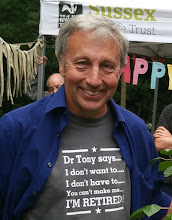Sussex Wildlife Trust’s
biggest woodland nature reserve is “The Mens” a fascinating ancient forest in West Sussex . The
name comes from the Old English “Gemenes”, meaning community woodland (German
speakers might recognise links with “gemeinschaft” which means community) and,
many centuries ago it was used by the local community for grazing and fuel
wood. For a long time now, however, it
has been left unmanaged.
When the SWT purchased it in
1974 we took the brave decision to leave it entirely to nature. “Brave” because
at that time the decision divided the SWT - some saw a dilapidated, untidy
place that needed to be cleared up and replanted. Fortunately, however, a non-intervention
policy was established so we now have a rare example of “old growth” woodland,
designated as of international importance.
This has given us an
excellent opportunity to follow natural processes at work. So, what have we learned about woodland
processes and how might this help us in the current discussion on wild land?
The 1987 storm was perhaps
one of the most informative events to hit woodland ecology for a
generation. People often thought of
woods as stable, undisturbed places that predictably developed to form a
dominant woodland type – the so-called climatic climax. George Peterken (one of Britain Forest ecology was not predictable, could be very
variable and therefore very diverse.
Storms are examples of unpredictable, formative events that drive
woodland ecology and benefit biodiversity.
Storms are good for woods and for the last 25 years I have been trying
to put over this as the antidote to the “devastating damage of the 1987 storm” stories
that we still sometimes hear.
Looking at The Mens you can
get a rough idea of what might happen in absence of disturbance (or at least if
disturbance is very light). The wood was
heading towards dominance by beech with an under-story of holly – two heavy
shade-casting and shade resilient species.
Other species were gradually reducing.
Oak, hazel, hawthorn, much of the ground flora and woodland lichens were
disappearing or becoming patchy. Other
species were doing well - such as fungi, fly species and hole-nesting
birds. The wood was becoming poorer in
some respects but unusual species were doing well.
Oak is a good example. Often assumed to be a woodland tree it does
not, however, regenerate in dense woodland.
This was born out in The Mens – age class studies show that there were
few very old trees, quite a lot of medium-aged trees but almost no young
trees. This is the classic sign of a
dying population – there are no young trees to replace the old ones as they
eventually die.
The storm, I thought,
provided the answer. Major gaps blown in
the canopy every few centuries would provide regeneration opportunities for all
the light demanding species that make up most of our flora. Sure enough, in the 25 years that followed
there was a huge pulse of regeneration in all the canopy gaps that were blown
in the wood. Broken trees sprouted,
shrubs grew, ground flora colonised and we saw a few more birds inside woods
that usually stay on the edges.
But the storm was not
enough!
Oak has not regenerated in
the wood and the canopy gaps are quickly returning to dense beech woodland. Storms are indeed vital to create diversity
and provide habitat for an array of species but alone they cannot explain the
presence of species that we know have been present throughout history.
The storm, however, is just
one case of natural disturbance. By
recognising the value of storms, it also opens our minds to recognising the
function of a great range of other forms of natural processes. Alongside storms is erosion and accretion by
rivers and lakes, tree fall on steep slopes, gaps formed when fungi or insects
damage swathes of trees and the disturbance caused by wild grazing animals as
they move through the forest. The
behaviour of grazing animals would also be affected by the presence of
predators which in turn would have affected the habitats they grazed or browsed on.
Even if we leave areas as
non-intervention, as we have done in The Mens, we cannot simply assume that we
have created wild land. In effect we are
making decisions by default by leaving areas alone – we have restricted nature
(any non-intervention area is too small), we have excluded large grazing
animals (they are extinct, not present or not allowed to behave naturally), we
have excluded predators, we react against natural disturbance (by clearing up
storm damage or preventing erosion) – and so on. So non-intervention is a positive management
decision which creates a human artefact as much as any other management
decision.
So why do we keep The Mens as
a non-intervention area?
In spite of the fact that
many natural processes are restricted in The Mens, any model for “the wild”
would probably have included large areas of old growth forest where natural
disturbance was indeed quite light. So
The Mens represents a type of habitat that would have been common in the
wildwood but which is now extremely rare.
Although the site may be poor in many woodland species, it is rich in
species that are restricted to old growth situations. Also, The Mens exists in a landscape
context. Open habitat in areas around
The Mens provide complementary habitat for many species that exist within the
wood, so we do not need to create extra canopy gaps to maintain the
biodiversity in the overall area.
The Mens is perhaps one of
the best examples we have of what a “near” natural wood might be like. It is a fascinating area to study. But most of all – just go there! It’s a magic place.

No comments:
Post a Comment